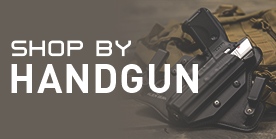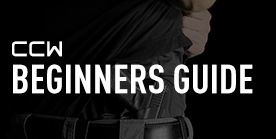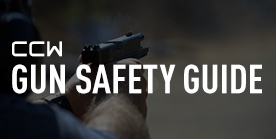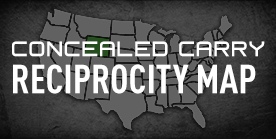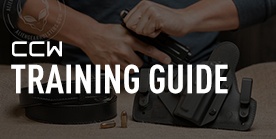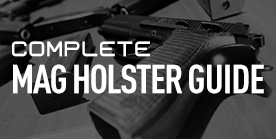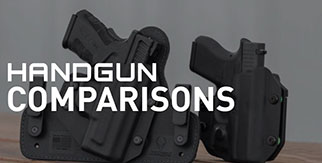
What Makes A Custom 1911 Different?
If you've ever handled or fired a custom 1911, you understand just how good that platform actually gets. This is something that's hard to fully describe to someone who doesn't "get" what makes 1911-pattern pistols so good.
You see, if you're used to factory guns (many of which are very good) it's hard to understand why anyone would pay so much money for a pistol, much less how it could be THAT much better than a Glock, M&P, Sig or what-have-you.
A custom, handmade 1911 pistol is a blend of art and science. Do you get your money's worth? That's arguable. What you're paying for is in the making of the pistol, which we'll go over as well.
A Gunmaker At Scale

Before we get into how a custom 1911 is made, let's describe how a typical gunmaker puts a pistol together. Bear in mind that this isn't to say guns made this way aren't reliable, accurate or well-made at all. The devil is in the details, but we'll get into that too.
The quick version goes something like this:
Factory makes the various parts in huge batches, especially small parts and springs. Often, small metal bits (triggers, guide rods, control levers) are made by metal injection molding to save costs without sacrificing too much quality.
The slide is machined out of bar stock. The frame is either cast from polymer or machined out of alloy or steel. A little polishing will occur, but not too much.
The parts are made to be within a certain range of tolerances so that there's sufficient clearance between all the parts. This allows for the gun to get cobbled together out of a parts bin within a few minutes. Factory techs take parts, put them together, then they test fire the gun. If it works, they box it and ship it.
Make parts, throw together, make gun. It's that simple.
Again, none of this is to say a factory gun is not well-made, will not be accurate or reliable or anything like that. It's also not that MIM parts are necessarily bad in and of themselves; it's more like MIM parts made to loose tolerances and out of poor materials are.
Start naming gun companies. That's basically how all of them make guns. Are Glocks bad guns? No. Do Smith and Wesson make bad guns? No. That's just how the thing is done at scale.
How A Custom 1911 Is Made
So...how does a custom 1911 made?
There are a number of companies out there making custom 1911 pistols, or at least making handmade 1911 pistols. Chances are you know a few names already. Les Baer. Ed Brown. Nighthawk. Wilson Combat. And so on. There are, of course, differences in how each company specifically handles production, but they all more or less make guns the same way in the broad strokes.
I actually had the chance to visit the booth of Roberts Defense, a custom 1911 shop out of Oshkosh, Wisconsin, at 2019 SHOT Show and their head gunsmith explained the difference to me. Unfortunately his business card has gone missing and I forget the gentleman's name, but you can check out their products on the Roberts Defense website. Having seen them in person, I can assure you of their impeccable quality.
I want one SO VERY BADLY. But one digresses.
A custom-shop 1911 starts as oversized blanks. Some firms mill slides and frames from bar stock, but others have pre-cut frames and slides made off-site from specifically selected types of steel or alloys. The blanks are solid metal and are milled, lathed and otherwise cut down to set tolerances. All the appropriate pin holes and other bits are drilled into the frame.
At this point, the frame and slide go to the gunsmith. The frame rails and slide rails are hand-lapped just until the slide can move on the frame rails.
The front of the grip is checkered, along with the mainspring housing. Custom guns often come with 25 lines-per-inch checkering, which is quite grippy.
Barrel bushings and barrels are both made by CNC machine. When they come off the machine, they don't fit in the gun. The bushing must be hand-polished and fit to the slide. Likewise the barrel must be hand-fit both to the slide and the bushing to ensure tight lock-up. The clearances between barrel, bushing and slide on a custom gun are usually only a few ten-thousands of an inch; the clearances are imperceptible to the human eye.
Sight cuts are milled into the slide, and sights installed.
Custom 1911 pistol makers usually make their own parts in house, instead of buying triggers, safety levers, grip safeties, hammers, sear levers and so on. These parts are made oversized by a few ten-thousands of an inch, just big enough to require a gunsmith to file away enough material for it to fit. The parts are polished and, once they can fit and operate, are fully installed.
You look at the back of the slide, and you'll notice the hammer, the extractor, the frame rails and the slide have no gaps between them.
The trigger is polished, removing material on the top, bottom and sides of the trigger blade and on the trigger bar where it has friction against the interior of the grip frame. This lets the trigger slide back perfectly, as if on rails.
Springs are installed except for the mainspring and it's housing, which must be polished to fit the frame prior to installation. After these parts are all installed, the grips are installed, which is actually the easiest part since you just screw them on. Some sanding may be involved if the grips have to be altered to fit a magwell, but that's still pretty easy.
In all, a typical handmade 1911 pistol usually takes 8 to 10 hours to assemble for a seasoned, experienced pistolsmith absent any customization, and each gun is made by one smith. Small shops like Roberts Defense can only turn out maybe a dozen guns per week, depending on circumstances. After assembly, some test firing, cleaning and they box and ship to the customer's FFL.
How A Factory 1911 Pistol Differs

Rest assured that most factory 1911 pistols are perfectly fine. Most are reliable, accurate and cleanly manufactured though not to the same standards as a custom gun. But let's go over some of the differences.
Where does your money go? Fitment. Factory pistols do not have the slide-to-frame, bushing-to-slide and barrel-to-bushing fit. That takes time that large companies like Colt, Springfield Armory, Sig Sauer and Remington cannot afford to take on guns. They cannot spend time hand-fitting the extractor, the thumb safety and the grip safety.
Factory pistols are assembled from parts. Grab the right ones, put it all together and the gun will run. The parts are made for that make and model gun but not your specific gun.
Custom shops mill their own parts. Many factory guns have parts made by MIM, which - it must be said - is not a guarantee of poor quality. A MIM part made of poor quality materials is a poor part, but MIM parts made with quality material is perfectly fine.
A factory gun's checkering will be made by knurling a raised bed on the grip rather than machined into the frame itself.
About the only thing that will receive the same attention is the sights, which don't take long to install anyhow.
So, the big difference is hand-fitment of all parts. In a handmade, custom 1911 pistol, everything is custom-fit on that gun and only for that gun. The clearances are impossibly tight, usually measured in ten-thousandths of an inch. A factory gun is put together from parts made by a manufacturer. "We're making a few dozen Government frames today, and a dozen Commanders. Only the Commanders get the extended beavertail and the ring hammers, boys!" and so on.
Does this add up to more reliability? Greater accuracy? Not as much as you'd think regarding the former IF your factory pistol is a good example (some lemons sneak out!) but the latter is a known quantity. Granted, your shooting skill comes into play (if you can't hit the broadside of a barn with a normal gun, you won't with a custom gun) but the tighter the gun, the greater the accuracy in most cases.
Why Should I Get A Custom 1911?

There are plenty of reasons NOT to get a custom 1911 pistol, such as cost (prohibitive, plan on spending $2500 at least) performance relative to that price (5 to 10 times as good as a factory gun? Not likely!) and so on.
But why would you want to?
First, there's the pride of ownership. Does anyone NEED an Aguirre y Aranzabal to shoot clays or pheasants? Or, for that matter, a Westley-Richards, Purdey, Boss or Holland and Holland? No; a Remington 870 or Mossberg 590 will do all the shotgunning you ever need. But people want them all the same.
Then you have the appreciation of the craft. Some people are willing to pay for quality because they appreciate it or want an item that they know they don't have to worry about. Anyone can go buy a LaZBoy or a sofa without problems, but a Morris chair by Stickley will last decades (possibly into the double digits) if cared for and not abused. If you're into music, you can get a Yamaha nylon string guitar for less than $200; you don't need a $30,000+ Hauser to make music.
Some people buy luxury goods because it's a goal, a reward for diligent savings or for reaching a milestone.
And so on. Basically, the reason to own one is that you really WANT one. Do you need that custom Commander 9mm 1911 to conceal and carry with? No, not really. It's more something that a person desires because it's a very fine thing, something you can take a lot of pride in owning.
 |
About The Author Born in southeastern Washington State, Sam Hoober graduated in 2011 from Eastern Washington University. He resides in the great Inland Northwest, with his wife and child. His varied interests and hobbies include camping, fishing, hunting, and spending time at the gun range as often as possible. |


